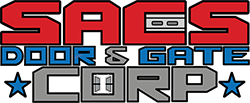Safe operation of your commercial garage door is always a concern for the business owner, in regards to your employees and the public. Statistics reveal that thousands suffer injuries from garage door accidents annually, including fractures, lacerations, concussions, severed limbs, and joint damage. Permanent disabilities and death can result from garage door accidents, so it’s in your (and everyone else’s!) best interest to do everything you can to prevent your commercial garage door from becoming a safety hazard.
Fortunately, with a little vigilance, you can ensure safe operation of your commercial garage door, and minimize your exposure to liability. Obviously, you’ve got OSHA standards and building codes to adhere to. And that will go a long way with preventing overhead door accidents. But there are some extra things you should also do to care or your employees as well as your reputation as a business. Because commercial garage doors are potentially scary.
What’s So Scary about Commercial Garage Doors?
Industrial garage doors are usually bigger and heavier than residential ones, and typically subject to more traffic and more openings and closings per day. More use means more wear and tear on the door and its moving parts. If you’ve slacked on regular inspection and maintenance, whether you do it yourself or have professionals like us come in, there’s a real risk of important pieces degrading to the point where the door can come off track, closes way too fast, or – worst case – falls.
The potential for injuries from any broken overhead door is significant, but with commercial garage doors it’s much greater, and not just because of the door itself; the presence of forklifts, trucks, and other commercial vehicles boosts safety concerns. A malfunctioning industrial-grade overhead door on a loading dock can make what should be routine inventory drop-offs and pickups into hazardous tasks that put employees at risk.
Sectional vs Coiling Doors
Sectional overhead doors and overhead coiling garage doors are the most common choice for commercial garage and loading dock door installations:
Sectional doors are hinged together, moving on tracks that run up the sides and then above the opening. (Think your typical home garage door on steroids.) The door may travel to a horizontal position above the floor as it rests in the guides. Sectional garage doors are sturdy and durable, but because they do have a lot of moving parts that are exposed to the elements, they do require regular inspection and maintenance like lubrication to keep them operating smoothly. Arguably, the biggest danger with these doors is if you leave the springs untended too long and they snap, because it will cause the door to close completely uncontrolled.
Overhead roll-up doors coil up above the door opening around a drum in a compact space. Rolling doors typically use heavy gauge steel formed into 2 to 3-inch horizontal interlocking slats. A coiling door requires less intensive maintenance than a sectional door. The parts are concealed in a coil, so are less exposed to damage or elements. Overhead coiling doors tend to be more durable than sectional doors, so they’re typically more expensive.
Regardless of the type of door you have or are choosing for your new commercial door installation, you’ve got other factors to think about when it comes to danger and damage. They can also be damaged by outside factors like vehicles, equipment or improper operation. One thing to consider when installing a new overhead door at your facility is to add automated commercial door hardware. Automated use of any industrial garage door eliminates human error of manual operation, which means less wear-and-tear, tighter security, and more streamlined loading dock processes.
Garage Door Openers and Preventing Freefall
Any garage door can fall. Motorizing opening and closing door cycles improves safety concerns about freefalling doors, but sometimes, that may not be an option. The manual operator may use a chain, hand crank or push-up operation. Chain hoists provide a means to operate a non-powered roll-up door; yanking on a chain to close a rolling service door, made of heavier-gauge steel, is potentially dangerous and can damage the door. A control chain operator may be the solution, in that it moves the door up and down with minimal effort, and has a braking system. Installing a simple braking system on the overhead doors at your warehouse or loading dock could prevent emergencies and workplace injuries.
Forklifts are a Nuisance to Commercial Garage Doors
Forklifts are a major cause of garage door injuries, according to OSHA, as well as a major cause of damage to overhead garage doors. A damaged door becomes more likely to cause injuries, especially if it is not opening or closing properly.
You might try installing a heavy bottom bar on a roll-up door, which will deflect force from any impact and help the door bounce back, resulting in reduced down time for repairs.
Forklift drivers often damage sectional garage doors when drivers forget to watch for overhead clearance while moving freight. Forklifts can also strike the head of a roll-up door, leading to costly repairs and even making the door inoperable. Installing a door protector helps prevent damages and injuries. It’s much better to replace a damaged protector than a damaged door.
Maximize Safety, Minimize Risk: Call in the Experts
Whenever damage occurs to an overhead door, you should call a qualified garage door specialist to inspect it and make repairs, if necessary. It’s important not to take chances with your employees’ or customers’ safety by operating a faulty door. Schedule safety inspections and regular maintenance so that all service doors operate efficiently and safely.

